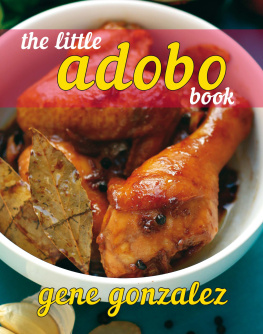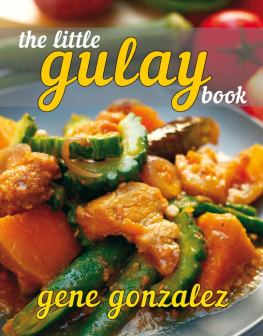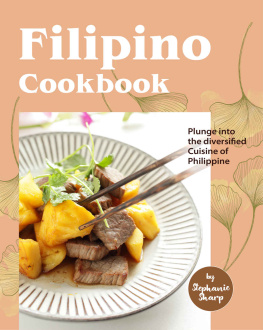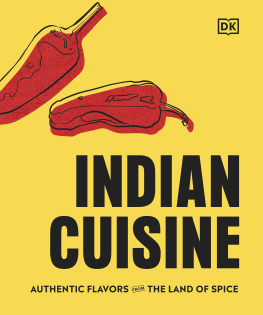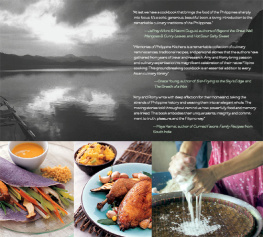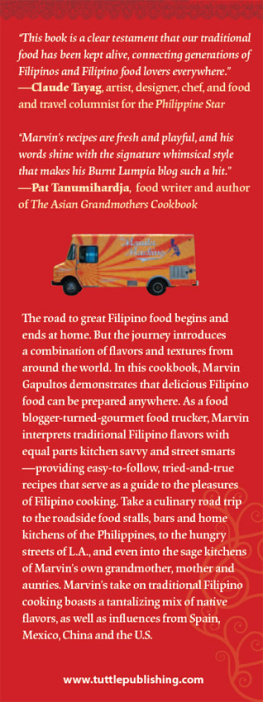The Little Adobo Book
Gene Gonzalez
Copyright to this digital edition 2015 by GENE GONZALEZ
All rights reserved. No part of this book may be reproduced in any form or
by any means without the written permission of the copyright owner and
the publisher.
Published and exclusively distributed by
ANVIL PUBLISHING INC.
7th Floor Quad Alpha Centrum Building
125 Pioneer Street
Mandaluyong City 1550 Philippines
Telephones: (632) 477-4752, 477-4755 to 57
Locals 815 and 817
Fax: (632) 747-1622
www.anvilpublishing.com
Book design by ANI V. HABLAN (cover) and JOSHENE BERSALES (interior)
Food styling by NOVIA DAVID ZAPATA
Front cover photo by CROWN DOLOT
Photo of the author on the back cover by WENDY BASILIO
Illustrations by MOISES NICOLAS
ISBN 9789712731891 (e-book)
Version 1.0.1
Adobo
I thought about a series of little books on Philippine cuisine and beverages as an easy, fast guide for today's cosmopolitan kitchens and busy bodies.
This first book in a series shows the ease of method and preparations for Philippine adobo, a simple dish that transcends gastronomic incompatibilities between Philippine regions and ethnic groups, each having their own versions of this cooking method plus its appeal to foreign visitors who find these dishes representative of true tropical cuisine.
Adobo to a Filipino is about as basic as one can get. It is a dish that can be served for breakfast, lunch or dinner or even for a round of friendly drinking. When one is unsure about the ingredient to be cooked, one simply makes an adobo. The miracle of flavors happens when a few pieces of chopped garlic infuses with spritzes of vinegar and blends with the other ingredients producing a truly appetizing yet simple and economical dish.
So here's The Little Adobo Book, a book that transgresses all seasons and culinary moods.
Introduction
B efore the coming of the Spaniards, the early Philippine inhabitants had used this cooking method of braising in vinegar and spices to increase the longevity of their food in a tropical climate when there was no refrigeration.
In the old days, when freezers were unheard of, the cooks had to rely on the sangkutsa method of pre-cooking in bulk. This consisted of slicing the meat into big chunks and pre-cooking them. These were half fried in plenty of lard and sauted in a lot of garlic, onions and salt. A little sukang Iloko (called vinagre in Bulacan) was poured in.
What turned out to be an ancestral cooking method is now being referred to as the Philippine national dish because of its appeal even to foreign tastes. Adobo is part of every Filipino table and is practical because of the ease of preparation and simplicity of ingredients.
Regional variations of the dish feature plentiful items found in the provinces where some of the recipes in this book are found. Taste can vary greatly with the addition of coco cream or lemongrass or a saut in achuete (annatto)-infused oil or turmeric. Vinegar such as palm, cane, pineapple, basi (sugarcane wine) give different dimensions as in patis or fermented fish sauce that could use anchovies, shrimps or other types of seafood. Cross-cultural mixes have given adobo other nuances such as the use of ngo-hiong (five-spice powder), toyo (soy sauce), rice wine and even Worcestershire sauce.
This book would have not been possible if not for the encouragement of three talented apprentices: Jennifer Tiano, Carla Ledesma, and Christine Paredes who pushed and prodded me to finally start writing and testing a small piece of yellowing paper they found posted on my refrigerator door the past two years. This was the outline of the little Adobo book and little did my students realize the start of their miniature nightmares when I had them test and improve the recipes I had compiled.
Special thanks also to Gino's Fine Dining, Chef Rizalina Chua and DJ Deloso, my assistant, Meg Soriano and Celia Padilla, manager of Lasap: Pagkaing Pilipino for their great cooperation and support.
And of course, to our Lord above who has given us many pleasures of the kitchen and table so that we may appreciate and enjoy the fruits of His creation.
Philippine Food and Life, Gilda Cordero-Fernando, Anvil Publishing, Pasig, Metro Manila, 1992, p.28
Contents
Ingredients
8 large cloves of garlic or 2 small fresh native garlic
2 tbsp. oil
700 grams pork (preferably with fat from the belly or back portion)
3 tbsp. vinegar
1/4 tsp. cracked peppercorns
2 tbsp. patis
1/2 tsp. salt | Procedure - Saut garlic in oil until golden brown. Add pork and stir-fry until brown.
- Add vinegar and simmer. Don't stir until vinegar boils and releases its acidic odor.
- Add pepper, patis and continue simmering until pork is tender.
|
| 
The Chef Says:
Variations to a basic adobo recipe vary from family to family such as the addition of bay leaf or soy sauce to the basic dish. Others put fresh green peppercorns or the actual peppercorn leaves. |
crispy pork shoulder adobo
Ingredients
1 kg. pork shoulder
1 tsp. curry powder
1/2 tsp. salt and 1/2 tsp. pepper
2 pcs. laurel leaves
4 cloves garlic, minced
1 pc. onion, chopped
50 grams pork, chopped
4 tbsp. vinegar
2 tbsp. soy sauce
1 laurel leaf
1/2 cup pork broth
a pinch of ground pepper
MSG to taste | Procedure - Marinate the pork shoulder with curry powder, salt, pepper, and laurel leaves. Boil the shoulder until meat is tender.
- Air dry for two hours by hanging on a roasting rack.
- Deep-fry shoulder until crispy. Set aside.
- For the sauce, saut garlic, onion, and pork.
- Add vinegar, soy sauce, laurel and seasonings. Simmer until reduced.
|
|
Ingredients
1 tbsp. butter
2 tbsp. olive oil
700 grams bibe (native duck), chopped into serving pieces
10 cloves garlic, slightly crushed
5 tbsp. wine vinegar
1/2 tbsp. green peppercorns
1/3 cup green olives
1 tbsp. patis
3 tbsp. brandy
1/2 cup chicken stock | Procedure - Heat butter and oil in pan. Sweat the duck to render the duck's fat. Let the duck turn brown before adding the garlic.
- Pressure-cook until tender. Add garlic and cook until slightly brown. Add vinegar and let simmer. Do not stir.
- Add pepper and olives. Add patis and brandy.
- Then add the chicken stock and continue simmering until the desired consistency of the sauce is reached.
|
|
Ingredients
1/2 kg. pagi (ray)
1/2 cup gata (coconut cream)
2 cloves garlic, crushed
1 medium onion, coarsely chopped
10 grams ginger, cut into strips
1 tbsp. vinegar
10 grams bamboo shoots, cut into strips
2 pcs. siling sigang (cooking chilies)
salt and pepper to taste | Procedure - Boil the pagi about 10 minutes until the black skin can be removed. Drain the water to lessen the strong odor of the fish.
- Remove the black skin and wad the meat, flake, then set aside.
|

